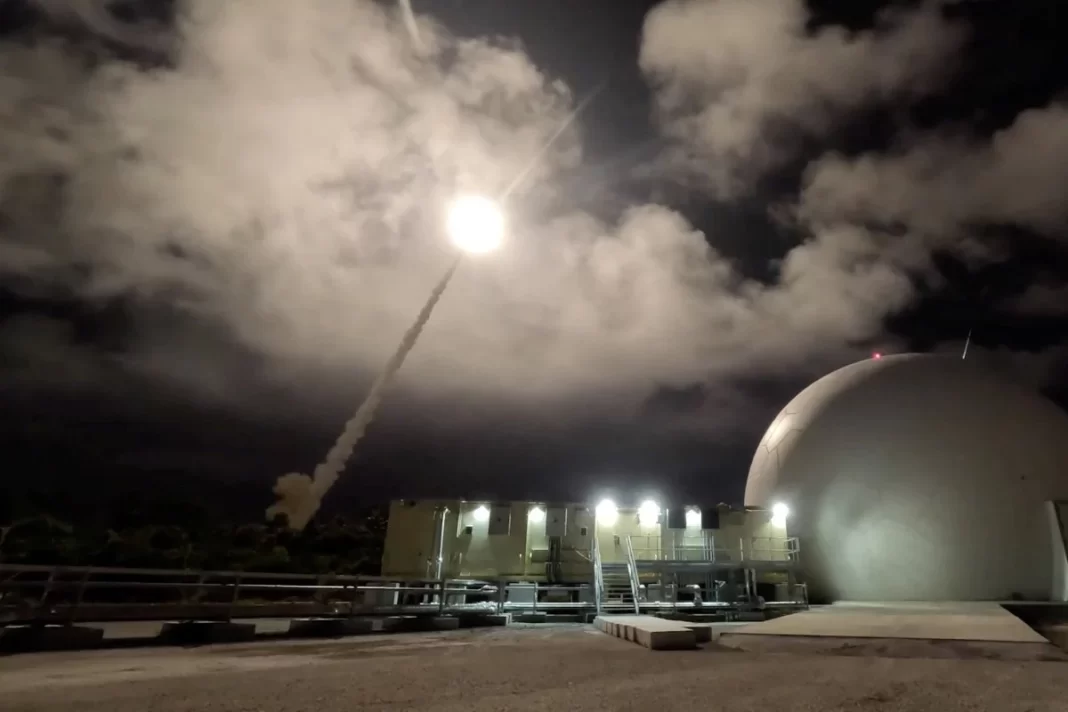The United States successfully conducted its first-ever live interception of a ballistic missile from Guam. This test marks a significant step in strengthening defense capabilities in the Indo-Pacific. With rising tensions between the U.S. and China, the experiment highlights Washington’s commitment to protecting its strategic bases and allies in the region.
A Historic Test on Guam
The experiment, called Flight Experiment Mission-02 (FEM-02), took place near Andersen Air Force Base in Guam. It involved the Aegis Guam defense system, which launched a Standard Missile-3 Block IIA to intercept a medium-range ballistic missile target. The target was launched from the air, simulating real-world threats.
This was the first time the U.S. used its new AN/TPY-6 radar system in live operations. The radar successfully tracked the missile’s trajectory, enabling the system to intercept it mid-flight. Military officials celebrated the test as a major milestone in enhancing Guam’s defense and readiness against potential adversaries.
Why Guam Matters
Guam is a small island in the Western Pacific, but it holds immense strategic importance for the U.S. military. Positioned near Taiwan and the Philippines, Guam serves as a hub for American forces in the Indo-Pacific. It plays a critical role in monitoring and responding to regional crises, including potential conflicts in the Taiwan Strait and the South China Sea.
China’s growing missile capabilities have made Guam a prime target. By conducting this test on the island, the U.S. has demonstrated its ability to counter advanced missile threats in real operational conditions. The data gathered will help improve future defense systems and ensure Guam’s security.
A Response to Growing Missile Threats
China has been rapidly advancing its missile technology. In September, Beijing conducted an intercontinental ballistic missile test using its DF-31AG missile, capable of reaching the U.S. mainland. The missile’s path near Guam highlighted the island’s vulnerability.
The U.S. has responded by expanding its missile defenses in the region. Recent deployments include the Typhon Weapon System in the Philippines, which can launch medium- and long-range missiles. These moves aim to counter China’s military buildup and protect American assets and allies in Asia.
Advanced Technology in Action at Guam
The success of the Guam test showcases the capabilities of the Aegis defense system and new technologies. The AN/TPY-6 radar system, combined with a tilting vertical launch system, provides a layered defense network. This allows for early detection and interception of missiles launched from land, air, or sea.
The Aegis system is designed to defend against a wide range of threats, including ballistic and cruise missiles. By integrating advanced radars and interceptors, the U.S. aims to create one of the most heavily defended zones in the world.
Implications for Regional Security
The test sends a clear message to China and other adversaries. The U.S. is investing heavily in its missile defense capabilities and strengthening its military presence in the Indo-Pacific. Guam’s enhanced defenses are part of a broader strategy to counter growing threats.
However, experts warn that China continues to modernize its missile forces at a rapid pace. While the U.S. has dispersed its forces across the region to improve survivability, it faces challenges in maintaining a military edge.
Partnerships in the Indo-Pacific
The U.S. is also working closely with its allies to bolster regional security. Japan and the Philippines have both announced plans to strengthen their missile defenses. Japan is considering deploying U.S.-made missile systems on its southwestern islands, while the Philippines is acquiring mid-range missile systems from Washington.
These partnerships aim to create a united front against potential aggression. By sharing technology and resources, the U.S. and its allies are building a more resilient defense network.
Preparing for Future Challenges
The Guam missile test highlights the growing importance of advanced defense systems in a changing world. With rising tensions in the Indo-Pacific, such measures are crucial for maintaining peace and stability. While challenges remain, the U.S. is demonstrating its ability to adapt and respond to evolving threats.
Guam’s strategic location makes it a linchpin of American defense in Asia. The success of this test not only strengthens the island’s security but also reinforces the U.S.’s commitment to protecting its allies and interests in the region. As the race for military dominance continues, tests like these will play a vital role in shaping the future of global security.

